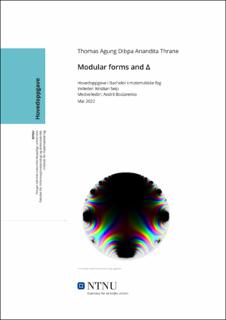| dc.contributor.advisor | Seip, Kristian | |
| dc.contributor.advisor | Bodarenko, Andrii | |
| dc.contributor.author | Thrane, Thomas Agung Dibpa Anandita | |
| dc.date.accessioned | 2022-08-06T17:19:35Z | |
| dc.date.available | 2022-08-06T17:19:35Z | |
| dc.date.issued | 2022 | |
| dc.identifier | no.ntnu:inspera:103848036:47729848 | |
| dc.identifier.uri | https://hdl.handle.net/11250/3010470 | |
| dc.description.abstract | Modulære former dukker opp i mange matematiske grener som topologi, tallteori, kompleksanalyse, gruppeteori, og algebraisk geometri. For eksempel, så ble de brukt i Andrew Wiles sitt bevis av Fermats siste teorem. De har til og med koblinger til den sporadiske monstergruppen via j-invarianten og måneskinnsteorien utviklet av Richard Brocherds. I dette bachelorprosjektet undersøker vi den enkleste varianten av modulære former, de med nivå 1 og heltallsvekt, ved å bruke kompleksanalyse, gruppeteori og lineær algebra. Vi bruker teorien for å vise at den modulære diskriminanten har multiplikative Fourierkoeffisienter, som var en av Ramanujans formodninger før Mordell beviste den i 1917. | |
| dc.description.abstract | The theory of modular forms sits in the intersection of the mathematical branches: number theory, complex analysis,topology, algebraic geometry and group theory. For example, they play a part in the proof of Fermats last theorem by Andrew Wiles and have surprising connections to the Monster simple group via the j-invariant and Richard Brocherds' moonshine theory. In this bachelors project we investigate the simplest case of a modular form, level 1 and integer weight, using undergraduate level complex analysis with a sprinkle of group theory and linear algebra.
We use the theory to prove that the modular discrimant, a special modular form, has multiplicative Fourier coefficients - a theorem conjectured by Ramanujan and proved by Mordell. | |
| dc.language | eng | |
| dc.publisher | NTNU | |
| dc.title | Modular forms and Δ | |
| dc.type | Bachelor thesis | |
